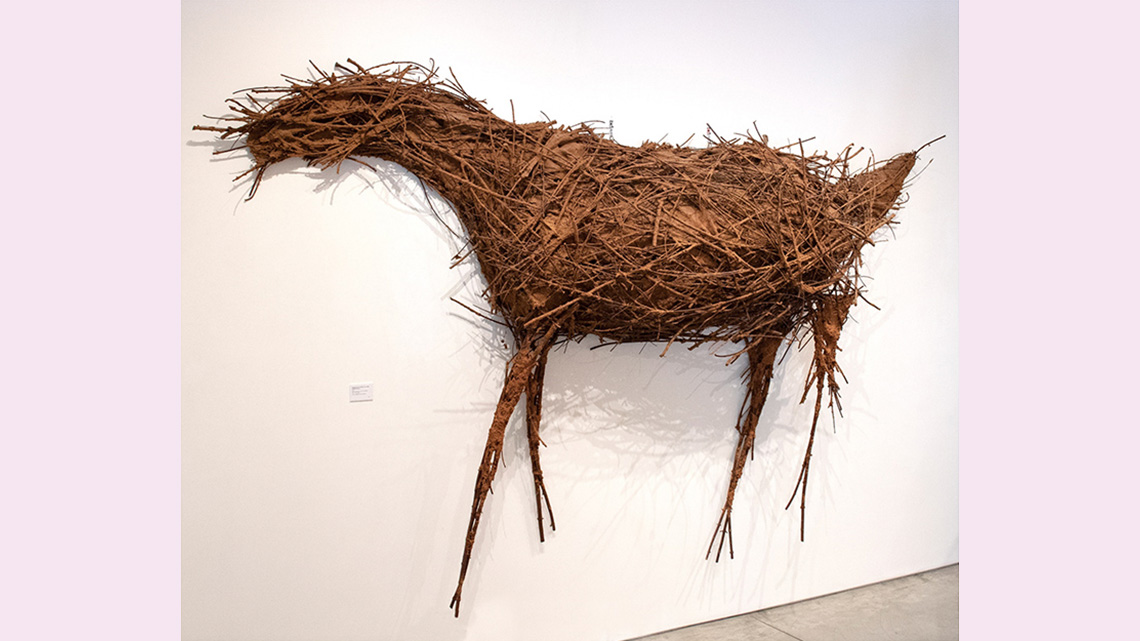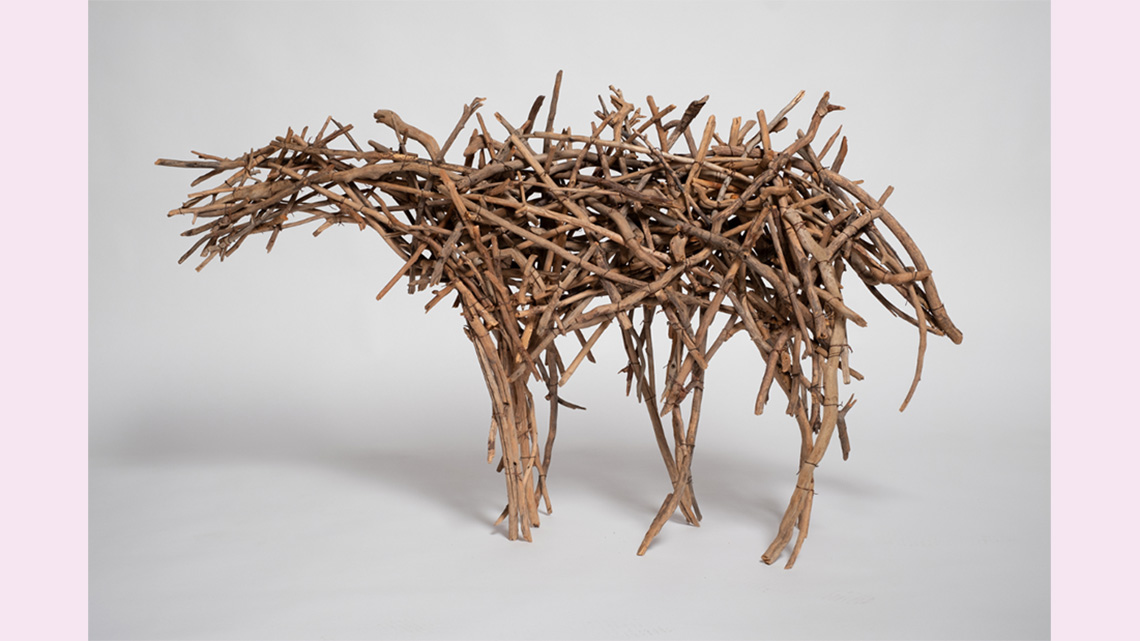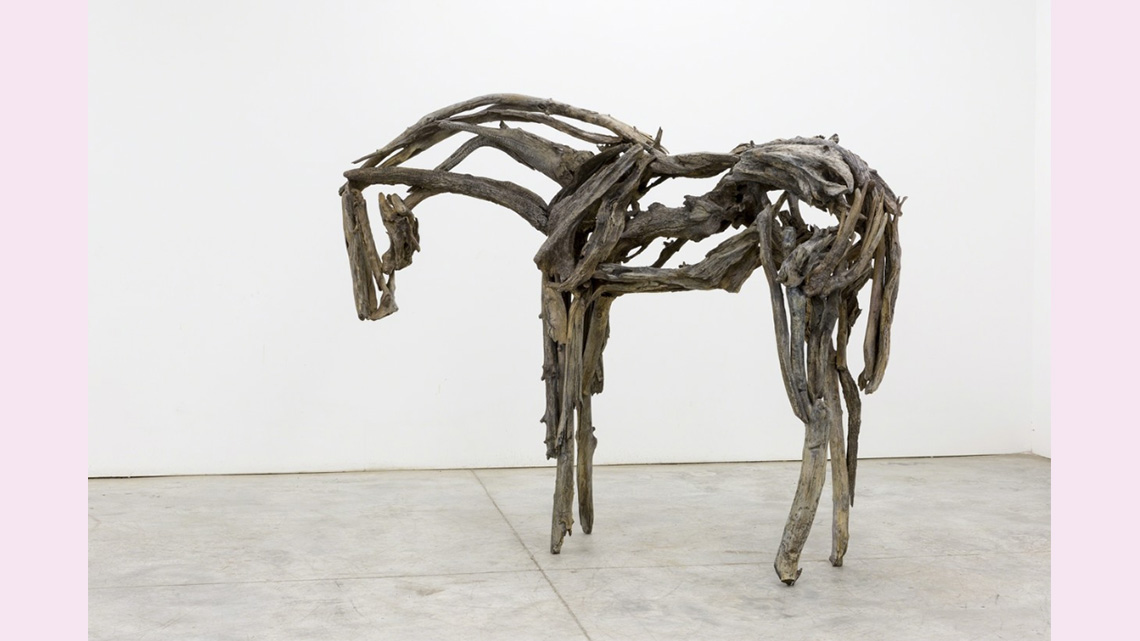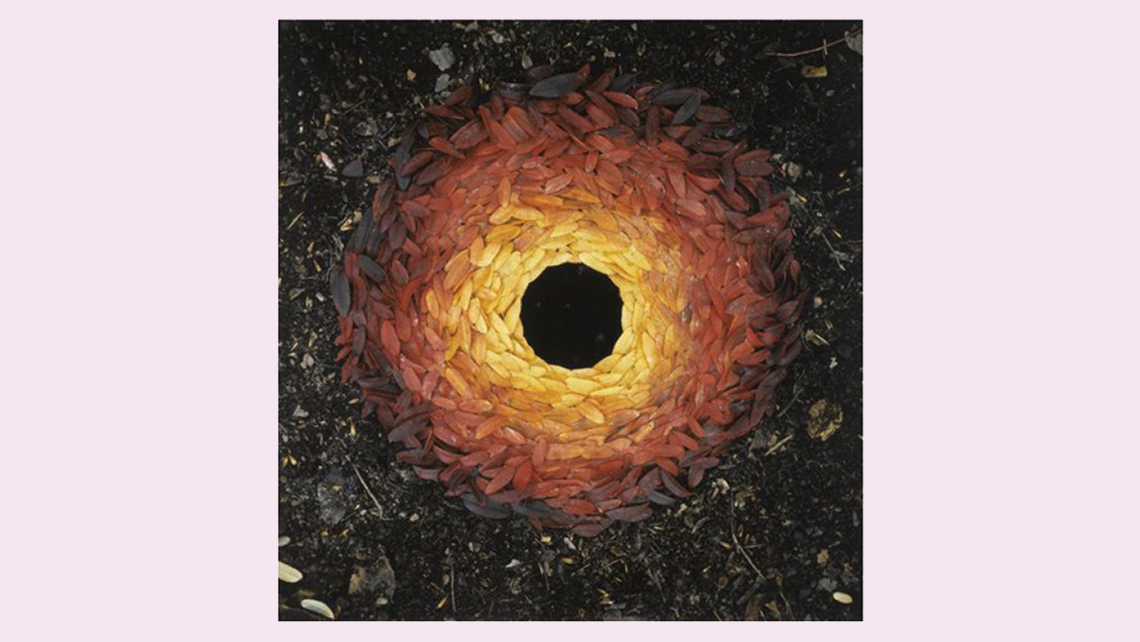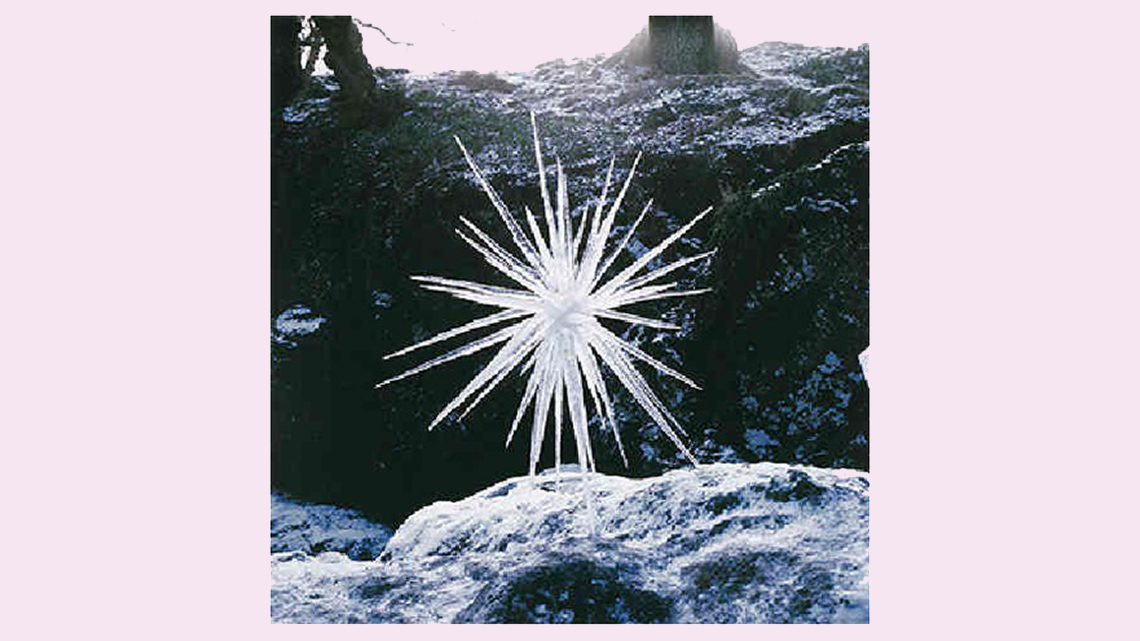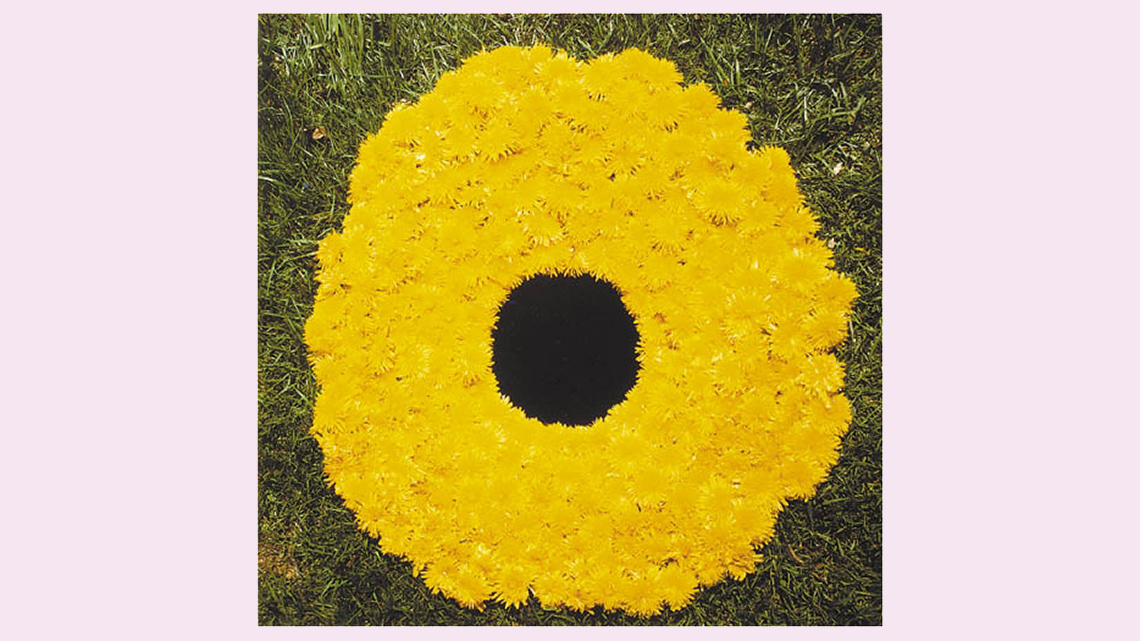Minds On
Let’s get started!
The art of Butterfield and Goldsworthy
Explore the art of Deborah Butterfield and Andy Goldsworthy and think about the following questions:
- What kinds of materials do the artists use to create their sculptures?
- What might the theme or main ideas be in each artist’s work?
Let us first examine the art of Butterfield.
A carousel of three images. Image 1: Untitled (Horse), Deborah Butterfield, 1981. A sculpture of a horse that was created using small sticks and branches for the torso, head, and legs. The frame was created using steel scraps. Image 2: Small Dry Fork Horse, Deborah Butterfield, 1978. A sculpture of a horse that was created using thick sticks for the torso, head, and legs. The frame was created using steel scraps. Image 3: Blackleaf, Deborah Butterfield, 2017. A sculpture of a horse that was created using weathered wood pieces placed together for the torso, head, and legs. The frame was created using steel scraps.
Now let us explore Goldsworthy’s art.
A carousel of three images. Image 1: Rowan leaves laid around a hole, Andy Goldsworthy, 1987. The sculpture was created using naturally found materials. It is a black hole in the centre surrounded by tiny fallen leaves that begin as yellow close to the centre. Toward the edges of the circle, the colours darken to orange, then red. Outside the circle, the leaves are of a different species and are green. Image 2: Icicles, Andy Goldsworthy, 1987. A sculpture that is made from real icicles found in nature. Each icicle is a straight line that meets the other icicles in the middle to create a three-dimensional star. This icicle piece was created on a rock where the artist found the icicles. Image 3: Dandelions collected on the way to Bretton laid around a carefully made hole, Andy Goldsworthy, 1987. The sculpture was created using naturally found materials. It is a black hole in the centre surrounded by dandelions that were collected by the artist. The dandelions have all been placed in a circular motion around the black hole in the centre to create a vision of a flower.
Action
Get ready, get set…
Who is Deborah Butterfield?

Deborah Butterfield is an American artist. When she first began creating sculptures in the 1970s, she used mud, clay, and sticks. Over time, she began adding scrap metal and recycled steel to her work. Her permanent sculptures are life-sized or slightly larger and are examples of found object and free-standing sculpture.
Found object
A found object is a natural or man-made object that an artist might use to create their artwork.
Free-standing sculpture
A free-standing sculpture is a sculpture that can support itself. It is three-dimensional. It has space all around it. It is designed to be explored from all sides. A free-standing sculpture is also known as a sculpture in the round.
Each piece takes months of finding materials and then metalwork. Butterfield assembles found tree branches and steel scraps to build the skeleton of each piece. For some pieces, like Blackleaf, she casts the pieces in bronze and then welds them together. Then, she creates a patina so that the work appears more natural.
Press ‘Description’ to know more about casting in bronze.
Heating the bronze until it is a molten liquid and then covering the sculpture in molten bronze. Once it cools, it creates a hardened exterior. The hardened exterior creates a protective coating over the natural material.
Press ‘Description’ to know more about patina.
Once the bronze coating has cooled and set, specific chemicals are added to the bronze to give the coating a specific appearance.
Check out the following video entitled Deborah Butterfield on Horses, Sculpture, & Creative Process where she discusses her first work that was cast in bronze.
- Why might this process be important when using the wood that she finds most interesting?
Who is Andy Goldsworthy?
Andy Goldsworthy is a British sculptor and photographer who creates installations using natural materials. He creates his work out of rocks, ice, leaves, or branches. His work is meant to be temporary, meaning that as the landscape changes, his work slowly breaks apart or disintegrates. He is also associated with the environmental art movement.
“We often forget that we are nature. Nature is not something separate from us. So, when we say that we have lost our connection to nature, we’ve lost our connection to ourselves.”
– Andy Goldsworthy
Press ‘Description’ to know more about the environmental art movement.
The environmental art movement emerged in the 1960s and early 1970s to celebrate artists’ connection to nature. Artists created sculptures in specific locations using found natural materials and then documented their work by taking photographs. The goal of environmental artists was to work with the natural environment instead of against it.
While many artists joined the environmental art movement to find connection to the natural environment, it is important to keep in mind that Indigenous peoples have been engaging in the practice of sustainability and respect and connection to the land for generations.
Traditional ecological knowledge, which refers to the environmental knowledge and sustainable practices, is what Indigenous peoples have developed over centuries. This knowledge comes from generations of Indigenous peoples living on the land, learning about specific plants, animals, environments, and the environmental factors that exist in a given area. Even as time goes on, this knowledge adapts to the ever-changing environment.
Pause and Reflect
Time to reflect
Let’s take a moment and think about the following questions.
- Why is it important to understand and learn about traditional ecological knowledge?
- Why is the Indigenous perspective important and necessary to include in the conversation about sustainability?
- Why might it be important to consider Indigenous peoples and their perspectives when it comes to taking care of the environment now and for future generations?
Share your thoughts with a partner, if possible.
Go!
Revisiting artwork
Let’s return to the examples of Butterfield’s work from the Minds On section.
A carousel of three images. Image 1: Untitled (Horse), Deborah Butterfield, 1981. A sculpture of a horse that was created using small sticks and branches for the torso, head, and legs. The frame was created using steel scraps. Image 2: Small Dry Fork Horse, Deborah Butterfield, 1978. A sculpture of a horse that was created using thick sticks for the torso, head, and legs. The frame was created using steel scraps. Image 3: Blackleaf, Deborah Butterfield, 2017. A sculpture of a horse that was created using weathered wood pieces placed together for the torso, head, and legs. The frame was created using steel scraps.
Pause and Reflect
Time to reflect
Based on what you have learned about Butterfield’s style and process, respond to the following questions.
- What is the form that Butterfield creates in her work?
Press ‘Answer’ to learn about the form that Butterfield creates in her work.
Butterfield creates life-size sculptures in the form of horses.
- How does Butterfield use line to create weight and depth in her work?
Press ‘Answer’ to learn about how Butterfield uses line to create weight and depth in her work.
Butterfield uses different kinds of branches to create contours of the horse forms. They become almost a three-dimensional gesture drawing, which creates weight and depth.
- What do you notice about the texture created in Butterfield’s artwork?
Press ‘Answer’ to learn about the texture created in Butterfield’s artwork.
In Untitled (Horse), Butterfield uses thinner sticks and layers them together to create the horse form. The texture seems to be coarse and rough. In Small Dry Fork Horse, she uses thicker sticks and arranges some in a cross-hatched pattern to create a bumpy texture. In Blackleaf, she has used even thicker pieces of found wood. The contour lines are more defined, and she uses positive and negative space to create a smoother texture and more fluid form.
- What might Butterfield’s sculptures mean? What kind of messages is the artist trying to convey?
Record your responses using a method of your choice.
Next, let us return to the work of Goldsworthy.
A carousel of three images. Image 1: Rowan leaves laid around a hole, Andy Goldsworthy, 1987. The sculpture was created using naturally found materials. It is a black hole in the centre surrounded by tiny fallen leaves that begin as yellow close to the centre. Toward the edges of the circle, the colours darken to orange, then red. Outside the circle, the leaves are of a different species and are green. Image 2: Icicles, Andy Goldsworthy, 1987. A sculpture that is made from real icicles found in nature. Each icicle is a straight line that meets the other icicles in the middle to create a three-dimensional star. This icicle piece was created on a rock where the artist found the icicles. Image 3: Dandelions collected on the way to Bretton laid around a carefully made hole, Andy Goldsworthy, 1987. The sculpture was created using naturally found materials. It is a black hole in the centre surrounded by dandelions that were collected by the artist. The dandelions have all been placed in a circular motion around the black hole in the centre to create a vision of a flower.
Pause and Reflect
Time to reflect
Based on what you have learned about Goldsworthy and his work, respond to the following questions.
- What kind of shapes do you notice in Goldsworthy’s natural sculptures?
Press ‘Answer’ to learn about the shapes in Goldsworthy’s natural sculptures.
Rowan leaves laid around a hole and Dandelions collected on the way to Bretton laid around a carefully made hole are created in the shape of a circle, while Icicles could appear to be the form of a sphere if the negative space was filled out and smoothed. Circles can symbolize wholeness.
- What kind of message might Goldsworthy be trying to convey by using these shapes?
Press ‘Answer’ to learn about the message Goldsworthy might be trying to convey by using these shapes.
Perhaps Goldsworthy is commenting on the wholeness found in nature, and how we should respect our environment.
- How does he create contrast in his work?
Press ‘Answer’ to learn about how he creates contrast in his work.
In Rowan leaves laid around a hole and Dandelions collected on the way to Bretton laid around a carefully made hole, Goldsworthy has created his sculptures around holes. The hole is dark, while the colours of the leaves and flowers are bright and lighter in contrast. This creates depth in his work.
- Why do you think Goldsworthy takes a picture of his artwork when he is done?
Press ‘Answer’ to learn about why Goldsworthy takes a picture of his artwork when he is done.
Goldsworthy’s sculpture work is temporary. This means that as the landscape changes, his work will scatter, melt, or disintegrate. Taking a photo helps capture the sculpture when it is complete.
- What might Goldsworthy’s sculptures mean? What kind of messages is the artist trying to convey?
- What are some of the similarities and differences between the work of Butterfield and Goldsworthy?
- How do both artists use found natural objects in unique ways?
- If you could create your own sculpture using found materials, what would you choose to use and why?
Record your responses using a method of your choice.
Consolidation
Putting it all together
Your turn
Portfolio
Track your progress
It’s your turn to design a sculpture using found materials! Consider what you have learned about Butterfield and Goldsworthy’s work. You may also create a detailed description or audio recording of your design.

Consider adding the answers to the following reflection questions to your art portfolio.
- What would you like your sculpture to represent? Is there a particular idea or subject you would like to explore?
- Would you create a temporary or permanent sculpture?
- Will your sculpture mimic a particular form, or will your sculpture be more abstract?
Complete the Designing a Sculpture Chart in your notebook or using the following fillable and printable document. If you would like, you can use speech-to-text or audio recording tools to record your thoughts.
Record your ideas using the following chart or using another method of your choice.
| Materials | |
|---|---|
| Theme or main idea | |
| Design |
Press the ‘Activity’ button to access Designing a Sculpture Chart.
Note: Consider labelling different parts of your design to indicate which materials you are using to complete each section.
Consider adding your design to your art portfolio. This portfolio can be a folder, on a shelf, or on your computer.
If possible, share your design with a partner.
Reflection
As you read through these descriptions, which sentence best describes how you are feeling about your understanding of this learning activity? Press the button that is beside this sentence.
I feel…
Now, record your ideas using a voice recorder, speech-to-text, or writing tool.
